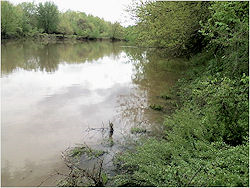EPA Research in Missouri

EPA researchers are working hard to protect communities across the nation. Learn about some of the work EPA researchers are doing in Missouri.
- Detecting and Measuring Ethylene Oxide
- Supporting Contaminated Groundwater Cleanup at a Superfund Site in Kansas City
- EPA Works with Dow Chemical Company to Collect Emissions from Natural Gas Boilers
- Using Green Infrastructure to Maximize Ecosystem Benefits
- Bridging the Gap: Investing in City Greenspace
- From East to West, EnviroAtlas Builds Bridges by Making Data Accessible
For more EPA work, see EPA in Missouri.
Detecting and Measuring Ethylene Oxide
Residents of Verona, MO expressed concerns about potential exposures to elevated levels of ethylene oxide (EtO), a hazardous industrial air pollutant. The concerns were related to a nearby chemical facility that regularly handles significant amounts of EtO as part of its standard operations. In response, EPA Region 7 staff reached out to colleagues in EPA's Office of Research and Development (ORD) to request an EtO air monitoring study. The study took place from 2022 to 2023, with the goal of measuring EtO concentrations in communities near the facility. Partner organizations used the data collected to improve the understanding of EtO concentrations in Verona near the facility and to communicate results transparently to the public. Read Detecting and Measuring Ethylene Oxide.
Supporting Contaminated Groundwater Cleanup at a Superfund Site in Kansas City
Groundwater, the water found below the Earth’s surface within the cracks and crevices of soil, sand, and rock, can be particularly challenging to treat. In 2023, EPA researcher Dr. Mohamed Hantush helped update a computer modeling tool that hydrogeologists can use to simulate the flow of groundwater accurately and efficiently through aquifers. The tool helps site cleanup professionals better understand how groundwater moves through and around a cleanup site and improves groundwater treatment plans. Read EPA Researchers Update Tool to Support Contaminated Groundwater Cleanup at a Superfund Site in Kansas City.
EPA Works with Dow Chemical Company to Collect Emissions from Natural Gas Boilers
One way EPA collaborates with partners is through Cooperative Research and Development Agreements (CRADAs). These collaborations can lead to improved research outcomes, and often, the creation of new intellectual property. EPA researchers signed a CRADA with Dow Chemical Company to measure stack emissions, including the air samples downwind of natural gas boiler stacks at Dow facilities in Midland, Missouri, using unmanned aircraft systems. Read EPA works with Dow Chemical Company to Collect Emissions from Natural Gas Boilers.
Win-Win: Using Green Infrastructure to Maximize Ecosystem Benefits
EPA researchers are working together to advance green infrastructure techniques in communities around the country. Learn about their efforts — including work with partners in St. Louis — to improve stormwater management and more equitably address a range of other community needs through environmental improvement projects. Read Win-Win: Using Green Infrastructure to Maximize Ecosystem Benefits.
Bridging the Gap: Investing in City Greenspace
Runoff from stormwater continues to be a major cause of water pollution in urban areas. To address this problem, cities are increasingly using green infrastructure—a variety of practices that use soil and vegetation to capture, filter, and reduce stormwater. EPA designed a framework to support the use of green infrastructure by assisting communities — including those in St. Louis — in making informed decisions surrounding stormwater planning and management. Read Bridging the Gap: Equitable Investment in City Greenspace.
From East to West, EnviroAtlas Builds Bridges by Making Data Accessible
In 2020, EPA published fine-scale environmental and ecosystem services data for Los Angeles, the District of Columbia, and St. Louis through EPA’s EnviroAtlas. EnviroAtlas is an interactive and free web-based tool that combines maps, analysis tools, fact sheets, and downloadable data to help inform state and local policy and planning decisions. EPA is working with the three new communities to share how they can incorporate the data into their work. Read From East to West, EnviroAtlas Builds Bridges by Making Data Accessible.
